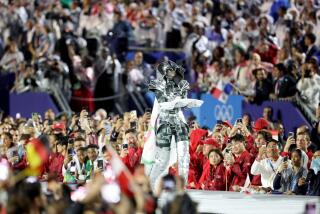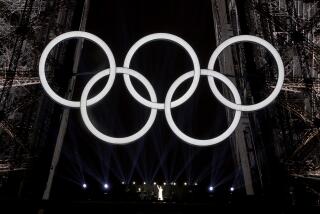The Man Who Conquered the Towers
OBERLIN, Ohio — Twenty-seven years ago, tens of thousands of people watched, shocked and transfixed, as Philippe Petit pulled off the performance of his lifetime. On Sept. 11, the man who walked a tightrope strung between New York’s World Trade Center towers, stood riveted by the same emotions and more, as he watched the twin towers crumble before his eyes.
Petit, who through an ingenuous, clandestine and defiant act long ago helped New Yorkers embrace the stark, square skyscrapers that anchored Manhattan’s skyline, immediately felt cut loose, as if the very high wire that has supported him so many times over the years had snapped. “I felt I was losing my home, my twin children--something very precious,” the self-taught high-wire artist said as the horror of the human tragedy swept over him.
Although he lives in upstate New York, Petit spent last week in Ohio as a visiting artist at Oberlin College in a program known as “Maverick Artists/Visionary Educators.”
“He provides sermons through magic, juggling, rope tying, high-wire walking,” says Linda Weintraub, a teacher and author who set up Oberlin’s Department of Emerging Art. “He talked about people’s expectations as a high-wire walker--they expect him to be graceful, every movement measured. But he loves to pretend he’s tripping; he’s studied Buster Keaton a lot.”
Years before the towers opened in 1973, Petit first saw an artist’s conception of what would be the world’s tallest buildings in a French magazine in a dentist’s office when he was 16. Spellbound, he drew a line between their rooftops.
He knew he had to have the magazine page but was reluctant to steal it from the crowded waiting room. So he faked an enormous sneeze to camouflage his ripping the page and fled the office.
“I had a toothache for a week,” he says, with no regret.
Petit, an impish, irrepressible 52-year-old with piercing blue-gray eyes and a shock of light brown hair, says he hopes to memorialize the recent tragedy by reenacting his second famous high-wire walk in New York. That walk, performed in 1974 in Central Park, was performed as penance for the first.
Petit was born in Nemours, just south of Paris, but grew up in the French capital, where he has kept a pied-a-terre for 37 years near the Pantheon in Paris’ Fifth Arrondissement. His father was a colonel in the French air force.
He started learning magic when he was 6. In his mid-teens he discovered juggling, then heard from a friend about the circus. “I heard this story of these incredible people walking on thin air.”
Petit strung a line between two cedars on some family land in St.-Germain-en-Laye, just west of Paris. He incorporated tightrope walking into the mime and juggling routines he performed for tourists in front of Les Deux Magots, a cafe on Paris’ bustling Boulevard St.-Germain.
By the time he was 18, he’d been thrown out of five schools for his antics.
“I have no diploma, no medals, no money,” Petit says. “I am a thief of knowledge. The irony is that now I’m teaching students, even IBM and Coca-Cola executives, about creativity.”
He has never owned a car and has no TV. “I’m a bit of a Luddite,” he says with a hint of pride. Except when planning one of his lightning assaults, which takes months or even years of preparation. “I am my own engineer. I study 15 years of weather data.”
Petit’s first guerrilla wire walk was at Notre Dame Cathedral in 1971. He and some friends sneaked equipment up the Gothic church’s two towers, tossed a rope from one tower to the other, and then he stepped out into the air, with only his 27-foot balancing pole.
Then came the Sydney Harbor Bridge in 1973, and the World Trade Center the following year. Since then Petit has spanned the Jewish and Arab sectors of Jerusalem, and sky-walked between the cathedral in Frankfurt and a nearby church. He is 11 years into planning his “masterpiece,” a proposed walk across the top of the Grand Canyon. “It’s a very, very hard life, but a beautiful life of expressing myself and not taking no for an answer,” Petit says ebulliently.
He spent a good part of nine years, mostly in France, practicing and planning the hardware that would be needed for the World Trade Center feat, a dizzying 1,350 feet above ground.
The biggest hurdle was getting the cable across the 140-foot stretch between the towers. Petit and a photographer friend, Jean-Louis Blondeau, mapped out the roofs in a cow pasture in Nevers, on the Loire River in Burgundy, experimenting with different techniques. “How to pass that first link? We tried a million things,” Petit recalls, his voice still heavy with amazement.
Nothing seemed fail-safe. But then Blondeau hit upon a way he was sure would work.
In December 1973, Petit arrived in the U.S. on his mission. During the next eight months he made scores of trips to the towers, often in disguise--as a journalist, a filmmaker, a construction worker laden with blueprints--measuring, photographing, poking into broom closets. For several days in August 1974, Petit sneaked equipment into the towering skyscrapers, hiding them in caches in the buildings and on the roofs.
On the afternoon of Aug. 6, he and his accomplices slipped into the buildings--Petit in full disguise, making a false delivery of some kind--and hid out in strategic nooks until nightfall.
“It was full of miracles and panic moments. Nothing happened as planned,” Petit recalls vividly. “It was like an attack on a bank, but it was an artistic crime, to forcefully impose my dream in an egocentric way, to do something beautiful to inspire people.”
Blondeau, using a powerful bow, shot an arrow from one tower rooftop to the other, trailing an invisible fishing line. Feverishly, they pulled a rope over, then a cable, and quickly tightened it to 2,500 pounds of tension.
At 7 a.m. Petit began his historic walk. Back and forth he went, seven times in 45 minutes, using only his pole and the buffalo-skin slippers he makes for himself. “It was a daydreaming performance, very different from a daredevil who walks across quickly to get into the Guinness Book of Records.” (Needless to say, Petit is in the book.)
Tens of thousands of astonished commuters paused to watch.
“There’s no risk involved,” Petit says. “When I put my first foot on the wire, I need to be sure there will be a last step.”
To him the wire is a metaphor of life: a journey that begins with that first step, that has a beginning and an end. He never uses a safety net, relying instead on his faith. “Whoever doesn’t walk the wire is not living,” he says. “If you don’t go through life and appreciate life, then you’re not living.”
Perhaps that is how Petit is able to deal with the loss of another child--not his steel twins in New York but his daughter Cordia-Gypsy, named after the cords that support him and his Gypsy-like lifestyle. “She was a wonderful, witty, rebellious child until she was 91/2, and a little volcano erupted in her brain,” he says, with a strength that seems can come only from having stared down death.
Petit is not even sure what affliction took her or what year it was--time, location, money mean little to him. “I don’t live on this Earth much,” he says. He is at his happiest when he’s on a wire, or perched in the lofty study he maintains in New York’s Cathedral of St. John the Divine, 60 feet above the nave, or even just looking up at the sky.
After his World Trade Center escapade, Petit was embraced by New York. He was convicted of trespassing and was ordered to stage a performance in Central Park. He ambled from a lakeside to the top of Belvedere Castle. And, perhaps inspired by Petit, other daredevils used the twin towers to make their marks. In 1975, a man named Owen Quinn jumped off one of the towers with a parachute, and in 1977, toy maker George Willig climbed an entire tower unassisted. Willig, dubbed the Human Fly, was fined $1.10--a penny for each floor he scaled.
These feats--dismissed as antics by some--helped win over cynical New Yorkers who had long been accustomed to the midtown Empire State Building as the world’s tallest,and resented the new structures.
Petit was given a lifetime VIP pass to the observation deck in the WTC’s South Tower and unfailingly took friends and family when they visited. He last set foot in the building one week before both towers were destroyed.
Petit lives in a rural home in upstate New York near Woodstock. On Sept. 11, he received a telephone call from a friend who shouted, “Philippe! Your towers are being attacked! Run to a TV!”
Petit has no television, of course, so he rushed to the house of a neighbor--the mother of Cordia-Gypsy, with whom he is good friends. “It was disbelief. My first thoughts were not at all my personal feelings about the tower, but first I felt in my guts the immense human tragedy of loss of life, and of not knowing about loved ones,” he recalls.
Only then did he feel his own personal loss. “There are tears and tragedy, but in front of defeat, one does not accept defeat,” he says. “Even now people hope to rebuild. I join all New Yorkers, and the world, in the comfort of hope, frowning at evil.”
He wants to “propose to do something magnificent.” He would like to reenact his Central Park high-wire performance as a concert in conjunction with his friend Sting, the recording artist, as an “opera in the air.”
As for the towers themselves, he says, “Let’s rebuild them again, exactly as they were, and I will dance between them again. It would be a magnificent gesture against doom.”
More to Read
The biggest entertainment stories
Get our big stories about Hollywood, film, television, music, arts, culture and more right in your inbox as soon as they publish.
You may occasionally receive promotional content from the Los Angeles Times.










